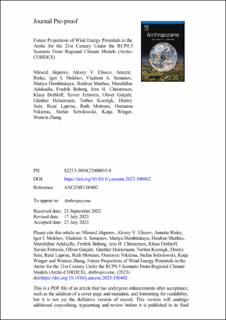| dc.contributor.author | Akperov, Mirseid | |
| dc.contributor.author | Eliseev, Alexey V. | |
| dc.contributor.author | Rinke, Annette | |
| dc.contributor.author | Mokhov, Igor I. | |
| dc.contributor.author | Semenov, Vladimir A. | |
| dc.contributor.author | Dembitskaya, Mariya | |
| dc.contributor.author | Matthes, Heidrun | |
| dc.contributor.author | Adakudlu, Muralidhar | |
| dc.contributor.author | Boberg, Fredrik | |
| dc.contributor.author | Christensen, Jens Hesselbjerg | |
| dc.contributor.author | Dethloff, Klaus | |
| dc.contributor.author | Fettweis, Xavier | |
| dc.contributor.author | Gutjahr, Oliver | |
| dc.contributor.author | Heinemann, Günther | |
| dc.contributor.author | Koenigk, Torben | |
| dc.contributor.author | Sein, Dmitry | |
| dc.contributor.author | Laprise, René | |
| dc.contributor.author | Mottram, Ruth | |
| dc.contributor.author | Nikiéma, Oumarou | |
| dc.contributor.author | Sobolowski, Stefan Pieter | |
| dc.contributor.author | Winger, Katja | |
| dc.contributor.author | Zhang, Wenxin | |
| dc.date.accessioned | 2024-04-10T07:57:55Z | |
| dc.date.available | 2024-04-10T07:57:55Z | |
| dc.date.created | 2023-10-05T10:21:36Z | |
| dc.date.issued | 2023 | |
| dc.identifier.citation | Anthropocene. 2023, 44 . | |
| dc.identifier.issn | 2213-3054 | |
| dc.identifier.uri | https://hdl.handle.net/11250/3125689 | |
| dc.description.abstract | The Arctic has warmed more than twice the rate of the entire globe. To quantify possible climate change effects, we calculate wind energy potentials from a multi-model ensemble of Arctic-CORDEX. For this, we analyze future changes of wind power density (WPD) using an eleven-member multi-model ensemble. Impacts are estimated for two periods (2020–2049 and 2070–2099) of the 21st century under a high emission scenario (RCP8.5). The multi-model mean reveals an increase of seasonal WPD over the Arctic in the future decades. WPD variability across a range of temporal scales is projected to increase over the Arctic. The signal amplifies by the end of 21st century. Future changes in the frequency of wind speeds at 100 m not useable for wind energy production (wind speeds below 4 m/s or above 25 m/s) has been analyzed. The RCM ensemble simulates a more frequent occurrence of 100 m non-usable wind speeds for the wind-turbines over Scandinavia and selected land areas in Alaska, northern Russia and Canada. In contrast, non-usable wind speeds decrease over large parts of Eastern Siberia and in northern Alaska. Thus, our results indicate increased potential of the Arctic for the development and production of wind energy. Bias corrected and not corrected near-surface wind speed and WPD changes have been compared with each other. It has been found that both show the same sign of future change, but differ in magnitude of these changes. The role of sea-ice retreat and vegetation expansion in the Arctic in future on near-surface wind speed variability has been also assessed. Surface roughness through sea-ice and vegetation changes may significantly impact on WPD variability in the Arctic. | |
| dc.description.abstract | Future projections of wind energy potentials in the arctic for the 21st century under the RCP8.5 scenario from regional climate models (Arctic-CORDEX) | |
| dc.language.iso | eng | |
| dc.subject | Klimamodeller | |
| dc.subject | Climate models | |
| dc.subject | Arktis | |
| dc.subject | Arctic | |
| dc.title | Future projections of wind energy potentials in the arctic for the 21st century under the RCP8.5 scenario from regional climate models (Arctic-CORDEX) | |
| dc.title.alternative | Future projections of wind energy potentials in the arctic for the 21st century under the RCP8.5 scenario from regional climate models (Arctic-CORDEX) | |
| dc.type | Peer reviewed | |
| dc.type | Journal article | |
| dc.description.version | submittedVersion | |
| cristin.ispublished | true | |
| cristin.fulltext | preprint | |
| cristin.qualitycode | 1 | |
| dc.identifier.doi | 10.1016/j.ancene.2023.100402 | |
| dc.identifier.cristin | 2181916 | |
| dc.source.journal | Anthropocene | |
| dc.source.volume | 44 | |
| dc.source.pagenumber | 18 | |
| dc.relation.project | EC/H2020/101003590 | |
| dc.relation.project | Meteorologisk institutt: 181090 | |
| dc.subject.nsi | VDP::Meteorologi: 453 | |
| dc.subject.nsi | VDP::Meteorology: 453 | |
